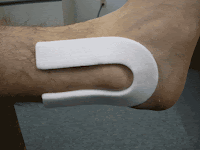Goniometry definition: the measurement of range of motion in a joint. It is used in diagnosis and rehabilitation of joint injuries. Both active range of motion AROM and passive range of motion PROM can be measured.
A goniometer is a tool used for measuring the joint.
There are several different types of goniometers including shape and size; some are designed for easier use at the different joints of the body.
Parts of a goniometer:
- protractor: the round aspect of the tool with the numbers used for measurement of degrees in joint.
- fulcrum: axis of rotation in the center of the protractor.
- stationary arm: is the arm that is a part of the protractor and is used for stabilization on proximal body part; it usually has a line drawn in the middle of it.
- movement arm: is the arm that is free moving around the fulcrum and is place on the distal body part that moves during joint movement; the arm usually has measurements on it.
When measuring a joint:
- Position the joint being measured in the neutral position.
- Locate the axis of the joint; this is where the fulcrum with be aligned
- Find the distal and proximal bony landmarks; this is where the stationary and movement arms will be aligned respectively.
- Measure the neutral position; that measurement will be equal to zero. Although some joints require a specific position to be recorded as neutral.
- Keeping the arms in the same spots you can record the measurements of flexion and extension; record these measurements and compare them to the neutral position measurement.
- You can continue this process bilaterally to compare the results of the injured to the uninjured structure.



